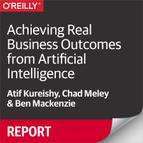Chapter 8. Conclusion
Companies are seeing value from artificial intelligence (AI) initiatives right now, and this is just the beginning of the transformational change we are soon to experience across many industries. In this book, we examined some real-life examples in which companies were able to address the challenges associated with AI initiatives in order to realize their value. To get started with AI at your own organization, we recommend the strategies outlined in this chapter.
Identify High-Impact Business Outcomes
You should begin introducing AI into your organization by first identifying the high-impact business outcomes that AI can address. Follow these guidelines:
-
Identify the areas where AI can make an impact in your organization.
-
Avoid deploying technology for technology’s sake. Instead, develop an understanding of what can—and should—be accomplished with AI in your organization based on the kinds of problems that state-of-the-art AI research is currently solving in other spaces.
-
Educate stakeholders to ensure realistic expectations for the technology and alignment on what is possible.
-
Clearly express your organization’s policies on AI and address head-on your staff’s fears and concerns regarding displacement or disruption due to automation.
-
Demonstrate the viability of the technology to solve problems in the areas you’ve identified, proving its value to stakeholders across different functions.
Assess Current Capabilities
The next step is to make an honest assessment of your organization’s current capabilities. The following are steps you can take:
-
Start by assessing your current capabilities and examining the platform, data governance, and data science abilities within your organization as well as your organization’s culture—will it facilitate an environment that rewards AI successes and learns from its failures?
-
Benchmark with peers and against your competitors.
-
Prioritize addressing capability gaps across the pillars of data, talent, analytics, and technology.
-
Consider engaging an independent third party in this assessment to ensure its thoroughness and veracity.
Build Out Capabilities
Finally, you should build out capabilities with the end in mind, as follows:
-
Right from the start, you should think about how analytics are to be made operational. Build and scale your solution following AnalyticOps best practices with continual retraining, monitoring, and governance, refining the system as needed until it is hardened and fully operational.
-
A successful AI program requires robust design thinking and bold experimentation. For this, you will need to move quickly, building agility into your processes so you can easily pivot based on new information gained from your successes and failures.
-
Resist any departmental rogue efforts that will deviate from the strategy and add complexity and costs. Siloed efforts are usually a symptom of inadequate communication or program funding. Moreover, they effectively kill the AI inspiration because transformation can occur only when data, analytics, and processes are aligned across departments toward one outcome.
The challenges of developing and deploying a custom AI solution are not insignificant, especially given that the field is still maturing. It will require strategic focus, a willingness to discover new ways to approach your business, and a commitment to innovation.
That said, there is too much to be gained by implementing an AI solution and becoming an analytics-forward organization to wait to start. This is an era of exponential change—your organization’s evolution is ready to begin now.
